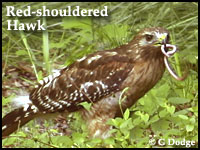Top Photo: Wood thrush.
A total surprise was a female Mallard with 7 ducklings in tow. I hadn’t seen a Mallard in the Wetlands for several weeks, other than the always present Mutt Duck (black and white female that’s been hanging around – mallard x domestic duck). On the 25th, both a male and female Mallard (the male molting and looking much like the female) were feeding alongside the Wetlands Overlook. As I stood there wondering where they’d come from, I noticed something moving in the water on the far side of the pond – a duck swimming out of the Willows with tiny ducklings following closely behind her. I had no idea they were even present, let alone nesting in the Wetlands! What else is lurking out there amongst the Willows?
A quick check of the Museum’s Cooper’s Hawk nest on June 16 came up empty – nothing but downy feathers scattered about the twigs and branches of the nest. But, on the 18th I saw four young hawks shuffling back and forth from branch to branch on the tall Loblolly Pine which holds the nest, apparently ready to go out into the world. Where were they two days before? Sitting quietly among the foliage? Out exploring the neighborhood? As it was, the leaf cover from the surrounding Sweetgums made it difficult to be certain, but it appeared that there were two females and two males (females are larger than the males). A return visit on Wednesday, June 25, found one of the youngsters sitting on the nest. Earlier that day I saw one of the adults headed towards the nest carrying food.
 On June 24, I noticed one of the Red-shouldered Hawks drop from a perch alongside the path next to the main entrance to Explore the Wild. It glided across the paved path and dropped down hard into the short grass, grabbing and clawing at something with its sharp talons and bill. When it brought its head up, it had a small Brown Snake in its beak. It swallowed the snake whole.
On June 24, I noticed one of the Red-shouldered Hawks drop from a perch alongside the path next to the main entrance to Explore the Wild. It glided across the paved path and dropped down hard into the short grass, grabbing and clawing at something with its sharp talons and bill. When it brought its head up, it had a small Brown Snake in its beak. It swallowed the snake whole.
Two new bird species seen during the period were Indigo Bunting and Killdeer. I would have expected the bunting back in April or May. Perhaps it was here all along and I just didn’t notice it? The bunting was singing from a Loblolly Pine in front of the Lemur House.
Killdeer, being plovers, are more at home on open grassland and barren areas. The bird that visited the Museum took two quick, erratic loops around the Wetlands trying to find a place to land, loudly calling the whole time. The resident Red-shouldered Hawk, who happened to be perched on a tall, straight snag out in the middle of the Wetlands, watched closely, its head spinning, trying to keep up with the Killdeer’s wild gyrations around the pond. The Killdeer seemed also to have upset the quiet solitude of a Green Heron who was standing on one of the short tree stumps projecting from the water – it squawking loudly and raising its hackles at the disturbance. No good mudflat to land on, the Killdeer left as quickly as it had arrived.
Wood Thrush and Hooded Warbler seem to be the only truly woodland species of songbird to still be in residence. Both were singing from the woods between the main entrances to Catch the Wind and Explore the Wild. I’ve only seen a male Hooded Warbler and don’t know for sure if there’s a female on site. Previously, a Hooded Warbler (maybe the same one) was singing down by the Lemur House.